
Drs. Paula Chakravartty (NYU) and Michelle Buckley (University of Toronto) received a grant from the Social Sciences and Humanities Research Council of Canada in 2018 for their project entitled “Mapping the Livelihoods of Urbanization: Construction Migration and Household Economies in Uttar Pradesh.” The Institute of Human Development and Social Change (IHDSC)recently met with them to learn more about their collaborative work to date. Their conversation was edited for clarity and length.
Could you provide us with some background about the challenges that this project seeks to address, the original idea behind the proposal, and some of the key outcomes to date?
Michelle Buckley: The challenges that this project seeks to address are ones that have been known for a long time with respect to migration into the Gulf region, but also internal migration [within India] among men and women who are employed in the construction trades and the building materials trades. Workers in these sectors are known to have working standards and employment relations that are transected by chronic employment standards violations, exploitation, danger on the job, and endemic wage theft where their wages and benefits are not paid either on time or not at all. In many cases forms of debt and credit that together can also lead to very distinct forms of unfreedom on the job. There have been a range of responses, both by labor-receiving and labor-sending countries and states, and part of the objective of this project was to take stock of some of these new moves by states to ensure decent and fair work. This study is particularly focused on the experiences of workers leaving from the state of Uttar Pradesh as it is one of the newer nodes in the Gulf-India migration corridor for construction work.
This project combines two groups of migrant workers that often are not considered together: brick kiln workers who migrate from Uttar Pradesh to neighboring states to work in brick kiln production facilities, and international migrants, predominantly men, who have been migrating from the state of Uttar Pradesh out to places like the Gulf States, but also Singapore and Malaysia.
IHDSC is home to many interdisciplinary collaborations, but your team is unique in that it bridges such disciplines as geography, media and communications, and political economy. How was your collaboration formed, and what are the benefits of bringing these disciplines together to study and address social challenges?
Paula Chakravartty: Michelle and my coming together resulted from an activist research network that linked NYU as an institution to global discussions about migrant construction workers from South Asia to the Gulf corridor. The building of the NYU campus in Abu Dhabi, alongside the Guggenheim and the Louvre among other well-known global cultural and educational institutions, on Saadiyat Island in Abu Dhabi brought us together. I was part of the Gulf Labor Coalition, a coalition of international artists, scholars and activists who came together around migrant workers rights. The Gulf Labor Coalition and the NYU Coalition for Fair Labor found that both the Guggenheim and NYU Abu Dhabi permitted forced labor conditions for thousands of workers in the construction of the museum and the NYU Abu Dhabi campus and its operation beginning in 2010. Michelle had done research prior on migrant construction workers from the south Indian state of Kerala who had been employed in Dubai, and she was part of a scholarly network that was supportive of our research and activism.
As someone trained in communications with a background in political economy and an interest in post-colonial studies, I began to see the real need for a critical interdisciplinary analysis of the problem of migrant labor conditions in the GCC countries given the dominant framing of the treatment of low-wage migrant workers. Both advocates and critics tended to exceptionalize the plight of migrant workers in the Gulf. For example, while media interest in precarious and largely invisible workforce through campaigns against “modern day slavery” might mean well, narratives that exceptionalize hyper-exploitation of the Kafala migrant sponsorship system can do more harm than good in terms of holding culpable institutional actors, whether the Guggenheim or NYU, accountable. In fact, Western cultural, educational and sports institutions seeking new markets in the Gulf are as likely to be beacons of liberal human rights in the region as Western multinational corporations from Apple and Amazon to Walmart; quick to blame local conditions and a murky web of sub-contractors each and every time they are accused of labor exploitation whether in the Gulf, or Bangladesh, China or Mexico.
The problem at hand is to de-exceptionalize and contextualize the conditions of racialized migrant labor exploitation while at the same time engaging in research that contributes to the advocacy for living wages and humane mobility and working conditions and the right to organize. Part of thinking, interdisciplinarily, across say media studies, geography, history and critical legal studies is to approach these questions in ways that can lead to different sets of analyses and answers. I've been really lucky to work with Michelle, who not only is a political economist and a geographer, but also brings to her research a feminist lens to think through low-wage work comparatively while foregrounding questions of voice and accountability.
Buckley: Labor rights and exploitation, particularly in the Gulf India corridor, have often been framed as fundamentally ‘unregulateable’ due to their informal management and transnational nature. Our project seeks to bring multi-dimensional perspectives and skill sets together to interrogate this. I have a spatial lens, and I would say that Paula brings so much to the project through her expertise in the discursive framing of problems and the informational landscapes and historical relations that shape contemporary processes of migration. I think those are really complimentary, as is our shared interest in feminist approaches to research and knowledge production.
In addition to that, this project is a partnership with a number of non-academic partners, including unions who work at a variety of scales within India and internationally. Their expertise and perspective has been incredibly valuable because it allowed us to see the interventions unions are making to shape construction and building materials work, and to better understand the complex regulatory fabrics that govern migrant workers' lives in these sectors.
This project includes a partnership with Khabar Lahariya, a United-Nations-recognized rural feminist media collective. How was that partnership initiated, and why is a collaboration like this important for your project?
Chakravartty: One of the missing dimensions of research is adequate attention on the voices and perspectives of migrants themselves, and Khabar Lahariya (which translates to “News Waves”) is a hyper-local news organization. It is reported, edited, produced, and marketed by women, most of whom are from marginalized communities in 13 districts in Uttar Pradesh (UP) and Madhya Pradesh (MP).
Our partnership with Khabar Lahariya really stemmed with a recognition that we wanted to do research that would feed back into the worlds from which these migrants came from. At this stage in my career, I’m less interested in research for the sake of one more peer-reviewed article. Instead, the project developed out of conversations where we together discussed what the ethics of research on and for migrants and migrant and labor advocates. Khabar Lahariya is really an innovative and inspiring news organization. They have played a significant role in changing the way that news is produced in India by and for a rural feminist readership/viewership. The majority of Indians today still live in rural areas, and yet the hyper-mediated life in India is largely understood as an urban reality. What is actually happening in the rural areas is quite invisible to most urban Indians and certainly for most urban upper class and upper caste Indians including those of us in the Diaspora. This project allowed us to partner with them in a moment where they were also hoping to expand what they do. We were able to work with them in ways that allowed them to rethink their capacity to combine research with journalism.
Buckley: Khabar Lahariya was also deeply involved in the research design for the project. They were essential in figuring out how this research was going to be structured, who was going to be part of the study, and they also carried out a lot of the interviews with workers and their families. Both they and our union partner, Building and Woodworkers International, were crucial in drafting the research questions, but also in helping us to build into the project a focus on the gendered dimensions of this work; for example, how construction and building work carries vastly different risks for men and women, but also how something like wage theft on the job site is connected to household wealth or how people's work on the job site is also connected to unpaid labor of spouses who stay behind.
An important aspect of this project is that it includes a knowledge mobilization plan and sets intentional goals around direct social impact. Could you tell us about some of the planned outputs?
Buckley: I would say that the project as a whole is shaping up to have three types of outputs so far. The first is what you would think of as the traditional academic outputs of reporting on findings within standard journal articles theorizing decent work or intervening in particular policy debates or debates around theory around employment and migration within this corridor.
The second part is particularly with our partners. When we designed this research, a key facet of it was to produce grounded interventions that would aim at creating change. When we were in the field, it was pretty apparent when we were talking to workers for the brick kilns that they actually didn't know a lot about available government support schemes and what their rights might be. One of the things we created with Khabar Lahariya and international labor lawyers was a “Know Your Rights” document, which is a two-pager translated into Hindi that could be handed out in the interview process. We didn't expect that to be one of the outputs, but it was something that unions told us was really important and that workers themselves were asking for.
We've also prepared reports that we have offered to unions that have been presented at India-wide union and government meetings in the last year. For example, we reported that workers rarely use the government e-migrate registration scheme to register themselves to formally migrate. The government came up with an expansive scheme to register online so that you could make sure that your rights are protected, and not a single one of the workers that we interviewed knew about it. We were able to say that there might be some disconnect here.
Thirdly, we’ve been incredibly lucky to learn from Khabar Lahariya’s expertise in storytelling. Normally this happens in their day to day work as journalistic reporting. But together we're looking now at creating a set of short documentaries that will explore workers’ and families’ own analysis of construction and brick kiln work in more detail.
Chakravartty: One of the things we wanted to do was allow for a space to hear about the worlds that these workers live within. We had questions like, “What do you do in your leisure time?” Well, there is no leisure time in these kinds of work worlds. One of the few places in which workers would talk to each other outside of the context of the worksite is in their travel back and forth. At least one of the documentaries will focus on one or more migrant workers traveling by bus or train from the worksite to home or vice versa. And it's actually that space of the bus or train journey that allows for conversations between workers about their mutual shared conditions of life.
The idea of doing this bus journey narrative is something that came from our collaborators. Often when we think about these migrant workers, whether migrant workers in the Gulf or these brick kiln construction workers, we rigidly separate the economic dimensions of life from more subjective and political realities. We are, of course, interested in building worker power to address economic exploitation, but connected to that is an issue of political subjectivity. They have very clear ideas about what a better world for them should look like. Partnering with Khabar Lahariya allows us to better learn from the migrants themselves, at least partially reversing the notion that they embody a “social problem” that only experts might solve.
How has the Coronavirus pandemic impacted your project and the communities that you work with? A Khabar Lahariya article from Spring 2020 mentions that there was a “mass exodus of migrant labourers from cities back to their hometowns after the nationwide lockdown was announced.”
Chakravartty: On March 23rd of 2020, the Hindu Nationalist Modi government announced a drastic and sudden lock-down giving 1.3 billion of its citizens a few hours to “shelter in place.” The mass exodus that's referred to in that article has to do with what happened to the tens of millions of migrant workers who suddenly lost their livelihoods and had nowhere to “shelter in place.” Our study focuses on one subset of low-wage migrant workers going from one state to another for work, mostly from rural to urban areas. The dramatic lockdown leaving millions of workers stranded and facing police violence, made visible the mostly invisible workforce of migrant workers to urban Indians and to the world. For Bundelkhand alone, which is the area that we were focusing on, some 600,000 migrant workers returned within a very short period of time, but the government made no preparation for how to get them from one place to another or for their safety and welfare.
Just like in the United States, the inequalities that preceded the COVID crisis have been cruelly reinforced by the pandemic in terms of gender and class, but as in the US with racial disparities, in terms of caste and religion . We saw the compression of those inequalities during the COVID crisis exposed, because when you have the biggest forced movement of people in India since the partition of 1947, it at least temporarily becomes an object of media attention.
Buckley: We have seen similar ways that temporary migrant workforces have been a pressure valve for global crises; during the global financial crisis of 2008, for example, Gulf firms shed thousands of workers who left the Gulf but were still technically still tied to their Gulf employer, and so had little capacity to find new and lasting work at home. I do think that there are broader insights from this brutal moment that illuminate the patterns and structural relationships between migrant workers, and state and market efforts to mitigate economic risks and costs.
Your current project focuses on migration economies and networks out of Uttar Pradesh, India, but are there findings or outputs that might be beneficial to other migration economies, such as networks within North America?
Buckley: One of our key aims, following so many other scholars in the region, is to de-exceptionalize the relationships of exploitation and unfreedom that transect construction work in Gulf, but also internally in North India. One dimension of that is to build on the work of post-colonial scholars such as Ananya Roy who contend that migration networks outside the global North must be crucibles for theory and knowledge making applicable to the global North. This does not mean ignoring the historical and geographical dynamics shaping North India's brick kilns, but rather considering what might connect work in these sectors to other forms of work elsewhere; for example, considering the geo-histories of British imperial regulation that might connect contemporary work in India to contemporary work in the United States. What colonial legacies of international law for example might allow us to draw lines of connection between worlds of work that seem to be very disparate?
Chakravartty: This morning I was reading the news coverage of the unfolding “migration crisis” under the Biden administration of the Central American migrants, especially children at the border who are being detained. We need to think about these issues historically, and we need to think about the kind of connections between what are seen as disparate and unrelated categories of migration, of mobility, and of citizenship and inclusion. To echo what Michelle says above, in terms of our research in India, we might consider the common theme of criminalization of low-wage racialized migrants which has a clear colonial history and renewed calls for abolitionist approaches to sanctuary.
Related Blog Posts
Reexamining the Link Between Pregnancy Intentions and Maternal, Newborn & Early Life Outcomes
Dr. Sarah Cowan received an IHDSC Seed Award in 2019-2020 for a project that reexamines and extends previous research on the links between pregnancy intentions and early life outcomes by analyzing data from the Pregnancy Risk Assessment Monitoring System (PRAMS) and 2-year follow-up data from six states.
Q&A: Young Women's Freedom Center and Dr. Shabnam Javdani
On the Ground interviewed Young Women's Freedom Center executive Director Jessica Nowlan and NYU Steinhardt professor Dr. Shabnam Javdani about the role of their research and partnership in working with girls, young women, and TGNC young people towards decriminalization, decarceration, abolition, and reimagining the juvenile justice system response.



